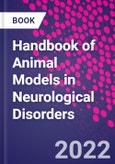Handbook of Animal Models in Neurological Disorders will better readers' understanding of a large variety of animal models and their applicability in studying a number of neurological disorders. Featuring sections on brain injury, stroke and neuroinflammation, this volume discusses in detail the utility, success and pitfalls of multiple models for each condition. Multiple disorders are covered, ranging from neurodegenerative diseases like Alzheimer's, Parkinson's, and ALS, to multiple sclerosis, headache, migraine, and others. With expert authors, this book has applicability for anyone pursuing neuroscience or biomedical research working to better understand, study and ultimately treat neurological dysfunction.
Please Note: This is an On Demand product, delivery may take up to 11 working days after payment has been received.
Table of Contents
Section 1: Alzheimer's Disease and Dementias1. Caenorhabditis elegans model of Alzheimer's disease: applications to drug screening
2. APPswe/ PS1dE9 mouse model of Alzheimer's disease: [18F]-florbetaben pet/ct imaging and beyond
3. Rat model of Alzheimer: applications to brain a-beta plaque accumulation
Section 2: Amyotrophic Lateral Sclerosis
4. Murine modelling of familial amyotrophic lateral sclerosis, SOD1G86R: applications to ambroxol HCl
5. Rat Model of amyotrophic lateral sclerosis: SOD1G93A applications to mitochondria
6. Zebrafish model of amyotrophic lateral sclerosis: applications to oxidative stress studies in spinal motor neurons
Section 3: Brain Injury
7. Murine models of traumatic brain injury and knock outs: investigations on hypocretin
8. Rat model of cortical impact traumatic brain injury: applications to studying neural stem cell grafts
9. Porcine modelling of traumatic brain injury: investigating agents such as valproic acid and beyond
Section 4: Cerebral Palsy
10. Animal models of cerebral palsy: a new narrative
11. Rat model of cerebral palsy: applications to studying motor phenotype
12. Rabbit cerebral palsy modelling: applications to studying spinal hyper-excitability
Section 5: Epilepsy
13. Murine modelling of epilepsy: applications to microRNA and hippocampus
14. Kainic acid-induced rat model of status epilepticus: A gamma-aminobutyric acid levels
15. Rats modelling of temporal lobe epilepsy: linking in cognition
Section 6: Headaches and Migraines
16. A new narrative of genetic mouse models of migraine: features and applications
17. Rat model of headache with nitroglycerin: impact of auricular electrical stimulation
18. Nitroglycerin-induced migraine in mice: Nociceptin Opioid (NOP) receptors and beyond
Section 7: Meningitis Rabbit tuberculous meningitis models: applications to neurosciences
19. Experimental pneumococcal meningitis: hippocampal DNA methylation
20. Pneumococcal meningitis modelling in mice
Section 8: Multiple Sclerosis Biological models in multiple sclerosis: a new overview and narrative
21. The mouse model of multiple sclerosis : use of Artemisia dracunculus L.
22. Comparing models of multiple sclerosis: applications to biomarkers
Section 9: Neuroinflammation Modelling neuroinflammation: CXCR2 signalling and myelin repair
23. Lipopolysaccharide- model of neuroinflammation: astrogliosis, microglial activation and beyond
24. Rat model of neuroinflammation: positron emission tomography (PET) tracer for imaging of P2X7 receptors
Section 10: Neurotoxins Animal models in the neurotoxicology of the neurotoxin 2,4-D
25. Toluene as a model neurotoxin in mouse models 1-11-2019
26. Rat model of alcohol-related brain damage: application to thiamine deficiency and cytokines
Section 11: Parkinson's Disease 1-methyl-4-phenyl-1,2,3,6-tetrahydropyridine( MPTP)-induced mouse model of Parkinson's disease: impact of Valeriana officinalis
27. alpha-synuclein BAC transgenic mice model of Parkinson's disease: the sublaterodorsal tegmental nucleus and beyond
28. Rat model of parkinsonism: the nigro-vagal pathway
Section 12: Peripheral Neuropathy Non-mammalian animal models of peripheral neuropathy
29. Mouse models of peripheral neuropathy: neurogenic molecule NSI-189
30. Rat model of cisplatin-induced peripheral neuropathy: features and applications
Section 13: Prenatal Related Injury Porcine model of intrauterine growth restriction: Applications to the study of the hippocampus
31. Ethanol as a neurotoxin in model primates for in vitro exposure: brain development and beyond
32. Prenatal malnutrition: linking in oxidative stress
Section 14: Stroke Mouse model of ischemic stroke: PET tracers
33. Canine model of stroke: optimizing complex multimodal treatment
34. Porcine Ischemic Stroke and applications to neural stem cells








